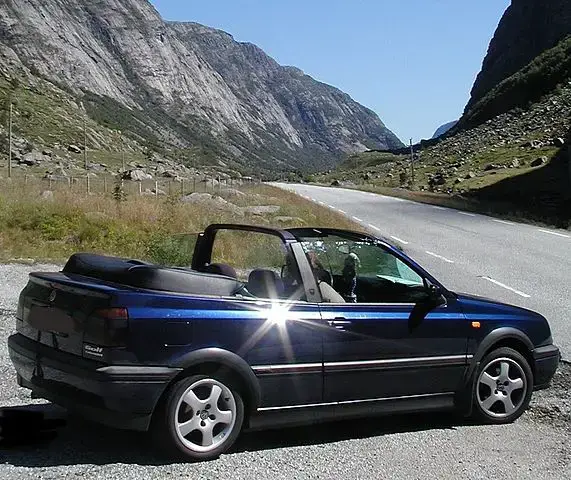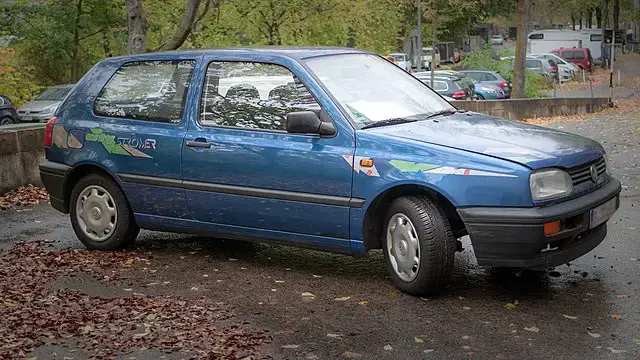Review: VW Golf III ( 1992 – 1997 )

So I can’t take it anymore. If I don’t write about the VW Golf III I can feel my nut swelling (I only got 1). If I don’t write now I feel like that. VW Golf III – one of the most requested almost cars on this site. Let’s get it going.
Straight into the world of non-wagons that you can buy for 25 euros. Launched in 1992, the VW Golf III was and still is the official car of farmers who didn’t have the money or were intimidated by the size of the Mondeo II estate. Entire farms and houses were built with the VW Golf III, and then it became the official car of the penniless beginner, who even today proves that it still can. Sure, it’s not as big a hit as the Golf IV or the “Summer of the Gypsi Kings – 16 songs, 17 hits”, but the VW Golf III remains an important car in the hearts of Europeans.
Just as the VW Golf V was an important step for VW, the Golf III came with many innovations in its time. The major difference was that the Golf V was a step in the wrong direction in the sense that they worked on image and pricing but decreased reliability, and the VW Golf III was a step in the right direction. All engines came with fuel injection instead of carburetion, it was the first Golf with standard airbags since 1992 and ABS since 1996, it was the first Golf in station wagon version, and, perhaps most importantly, it was the first Golf to have the famous 1.9 TDI that was to take Europe by storm more than Eiffel 65 with the Blue song. And so we have the genesis of the european car – the 1.9 TDI estate, manual, that goes on forever and back with minimal maintenance. What does it matter that you’re digging your hand through the floorboards from so much rust and that the interior is even poorer than a dorm room, the important thing is that you have low consumption and the fact that you can take your mechanical knowledge from the Dacia and use it on the VW Golf III.

VW Golf III Engines
Petrol
- 1.4 MPI of 60 horsepower – Reserved for the Polo 6n, you’d think this would be the slowest engine in the VW Golf III. And you’d be wrong. It’s the second slowest engine. Plus it doesn’t mesh at all with the manual transmission so you’d rather spend an extra 100 bucks and get a more powerful version.
- 1.6 MPI of 75 and 100 horsepower – By far the most balanced engine for the VW Golf III in 2020 because this engine revs infinitely, even if it skipped the lessons on fuel efficiency. But at least it’s cheap to maintain and won’t break down anytime soon.
- 1.8 MPI of 75 and 90 horsepower – Surprisingly, this is the second most popular engine in the VW Golf III. I don’t know why or how either.
- 2.0 GTI of 116 horsepower – I laugh that this engine normally sacrifices performance and fuel economy for total reliability. At least that’s the story with the Skoda Superb, Golf IV, and Passat B5.5. Except in the case of the Golf III which weighs as much as a bottle and the engine suddenly becomes more delicious than Sofia Boutella.
- 2.0 GTI 16v of 150 horsepower – Double the number of valves and we enter the zoster zone of the automotive world, with a Golf III GTI that has retained as much as possible the essence of the original GTI.
- 2.8 VR6 of 175 and 187 horsepower – I highly doubt there are people who wake up in the morning and then dream of a Golf III with a 2.8 petrol engine, but you never know. Is there any point in talking about the water pump and coil packs on this engine or does it not matter anyway compared to the tax and insurance value?
Diesel
- 1.9 D / SDI 64 horsepower – If you’re rushing somewhere, you’ll have to walk away. And it’s not even as reliable as you’d imagine, having crankshaft pulley issues and the classic electronic issues. Add another 10 euros to your budget and go for a turbocharged model.
- 1.9 TDI 75, 90, and 110 horsepower – The 75 is as old as Stan Lee so I’ll go ahead and talk about the 90 and 110 horsepower. The engines are shared with the Audi A4 B5 and Passat B5 so they need no introduction. It’s not quite the ALH that brainwashed the whole of Europe, but that’s where all the madness starts.

VW Golf III General Issues
- A general concern with the clutch cable that breaks as if it were Coldplay’s ear every morning. All models are affected so you will have to save up 3 euros for a new cable.
- Automatic boxes existed but it’s better to stick to the “they existed” phase. Don’t go looking for a VW Golf III automatic because you’ll have to do the work yourself until you find it and then fix it.
- The front suspension is another sore point, especially on the damper and arm part. Another 10 pounds to put aside.
- Golf III was one of the first VW models to come with electronics, and history has shown us that VW is not good at implementing new technologies, from TSI to Adaptive Cruise Control, and Golf III keeps the tradition. So take it and check that all the buttons work.
- And then there’s the bigger issue, which is rust. The VW Golf III is famous for the way it can rust and it’s not a question of finding a rust-free car, it’s a question of finding a car with acceptable rust. VW Golf III – the official car you can put your hand through the bodywork.

VW Golf III Verdict
A car that didn’t impress but laid the foundations of what modern VW is all about. Like the Audi A4 B5, the Golf III comes from an era when cars were simple, reliable, hard-working, and far removed from the idea of premium cars. Like the Ford Mondeo II, no matter how much abuse this car takes, no matter how neglected it is, the Golf III will carry its bodywork, bags of cement, half-pigs, wine bottles, dead drunk neighbors who are no longer mobile, and pretty much anything else you can imagine carrying in the countryside with dignity. It could have easily been released under the John Deere license.
What engines do I recommend? For petrol, I’ll go with the 90hp 1.6 MPI although you can go with the 1.8 aswell, and for diesel clearly the 1.9 TDI, whichever version you find.
Similar Articles

Review : Skoda CitiGO ( 2011 - 2020 )

Review : Seat Mii ( 2011 - 2020 )

Review : VW Up! ( 2011 - 2023 )
Write an answer
- Review : Skoda CitiGO ( 2011 - 2020 ) 02 August 2025
- Review : Seat Mii ( 2011 - 2020 ) 02 August 2025
- Review : VW Up! ( 2011 - 2023 ) 16 July 2025
- November 2025
- October 2025
- August 2025
- July 2025
- April 2025
- March 2025
- February 2025
- January 2025
- December 2024
- November 2024
- October 2024
- August 2024
- July 2024
- June 2024
- May 2024
- April 2024
- March 2024
- February 2024
- January 2024
- December 2023
- November 2023
- October 2023
- September 2023
- August 2023
- July 2023
- June 2023
- May 2023
- April 2023
- March 2023
- February 2023
- January 2023
- December 2022
- November 2022
- October 2022
- September 2022
- August 2022
- July 2022
- June 2022
- May 2022
- March 2022
- April 2021
- January 2021
- December 2020
- November 2020
- October 2020
- September 2020
- August 2020
- July 2020
- March 2020